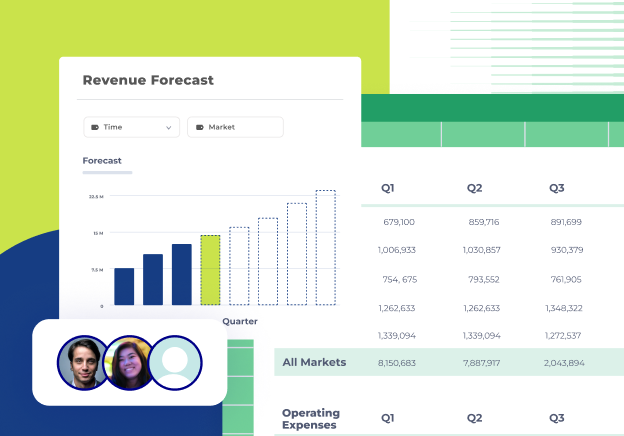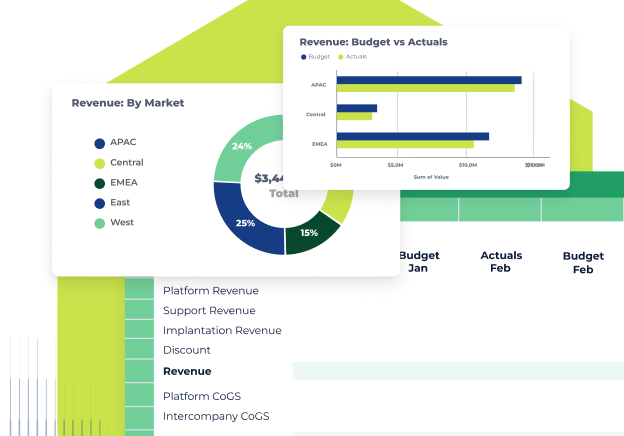Product
Solutions
resources
Company
Congrats on your score!
Your FP&A is Refined.
Your FP&A is firing on all cylinders—leveraging cutting-edge planning tools to drive strategic impact. But, don't rest on your laurels just yet. Enhance forecasting precision even further by using the latest technologies and uncover new business opportunities hiding in your data.
Grow your FP&A prowess
It's not just about the plan, it's about the pivot. To become a great strategic finance team, you need to think two, three, or five steps ahead. Here's where you should focus next.
Break down
silos
Fully integrate financial planning with operational plans, sales projections, and strategic goals across all functions. This tight cross-functional alignment is what will cement your position as a trusted strategic advisor.
Become a forecasting powerhouse
Use ML, predictive analytics, or statistical models to improve forecast accuracy. Combine these with real-time performance data to constantly update and refine your plans.
Build an insights engine
Set up a central system for all financial and operational data. Automate data collection and reporting to cut down on errors and manual work. This allows you to give quick insights for faster, smarter decisions.
Where are you on the path to strategic finance mastery?
1
Foundational
Laying groundwork
- Not yet fully aligned with the broader strategic goals of your company
- Work to be done to standardize the planning process outside of the annual budget
- Basic financial model and reporting
- Operating with unstructured data and no formal model or static model
2
Developing
Iterative improvements
- Finance part of decision-informing processes at a broader level
- Annual planning process (not clearly defined) but with occasional reporting to stakeholders
- Non-value-added tasks are automated. Starting to implement basic best practices, along with an annual planning process
- Leveraging a partially driver-based model
3
Defined
Holistic FP&A
- Finance provides critical insights and analysis that drive decision-making
- Defined planning process with regular reporting cadence and communication with stakeholders
- Clearly defined reporting, planning and performance management, and company-wide collaboration
- Fully driver-based model
4
Refined
Optimized XP&A
- Finance is fully connected to the strategy, and drives innovation, helping to shape strategic direction
- The annual planning process is defined where owners can drive updates and changes to/from finance independently with approvals
- Standardized performance management that reduces cost, improves speed, accuracy, and transparency of forecasts and reporting
- Leveraging a fully driver-based model with automation from users and systems
5
Masterful
XP&A mastery
- Finance is a key driver of change and is recognized as a strategic partner at the highest levels of the business
- Predictive / statistical forecasting is combined with performance management and iterative planning, replanning, reporting, analytics, and reforecasting
- Fully driver-based and in real-time
The guiding principles of strategic finance
Foresight
The proactive anticipation of future financial trends and challenges, enable companies to make informed decisions and strategic plans. This principle emphasizes the use of data analytics, scenario planning, and forecasting techniques to predict potential outcomes and mitigate risks.
Alignment
Financial strategies and goals should closely align with your business objectives and operational plans. Strategic leaders foster collaboration across departments, ensuring everyone works towards a common mission.
Storytelling
Storytelling in FP&A transforms complex financial data and analyses into compelling narratives that stakeholders can easily understand and act upon. Effective storytelling bridges the gap between financial experts and non-financial stakeholders, facilitating better decision-making.
Balance
FP&A involves managing the trade-offs between short-term financial performance and long-term strategic goals. Careful evaluation of risks and opportunities is a heavy weight on a finance leader’s shoulders. By striving for balance, organizations can navigate financial complexities while achieving both immediate and future objectives.
Learn from finance professionals just like you
“If you're not building the relationships with your team, departments, and customers it gets harder to do your job.”
Julia Coto
CFO, Chartspan Medical Technologies
"Human error is going to create mistakes. You can’t audit every line."
Amanda Hoppe
Director of Finance & Adminstration, Freedom Games
“The CFO is much more of a strategic role nowadays, and that extends down into finance and FP&A.”
Allen Michaelis
Senior Director of Finance, Bluewind Medical
“If you're not building the relationships with your team, departments, and customers it gets harder to do your job.”
Julia Coto
CFO, Chartspan Medical Technologies
"Human error is going to create mistakes. You can’t audit every line."
Amanda Hoppe
Director of Finance & Adminstration, Freedom Games
“The CFO is much more of a strategic role nowadays, and that extends down into finance and FP&A.”
Allen Michaelis
Senior Director of Finance, Bluewind Medical
Bookmark these FP&A
and finance resources
.png)
Management reporting
How to empower non-financial executives to understand the numbers
Explaining financial numbers to non-financial executives can be a challenge. Here are our top tips for communicating with all types of business leaders.
Read more
-1.png)
Budgeting & Forecasting, Ebook
The future of strategic finance
Discover how to transition from day-to-day financial tasks to becoming a driver of business strategy.
Read more
%20(1).png)
Management reporting
Slides: The top 5 mistakes CFOs make when communicating with the board
What are the top 5 mistakes CFOs make when communicating with the board? Here's the slide deck our CFO-turned-CEO used in a CFO leadership council webinar.
Read more


.png)









.png)